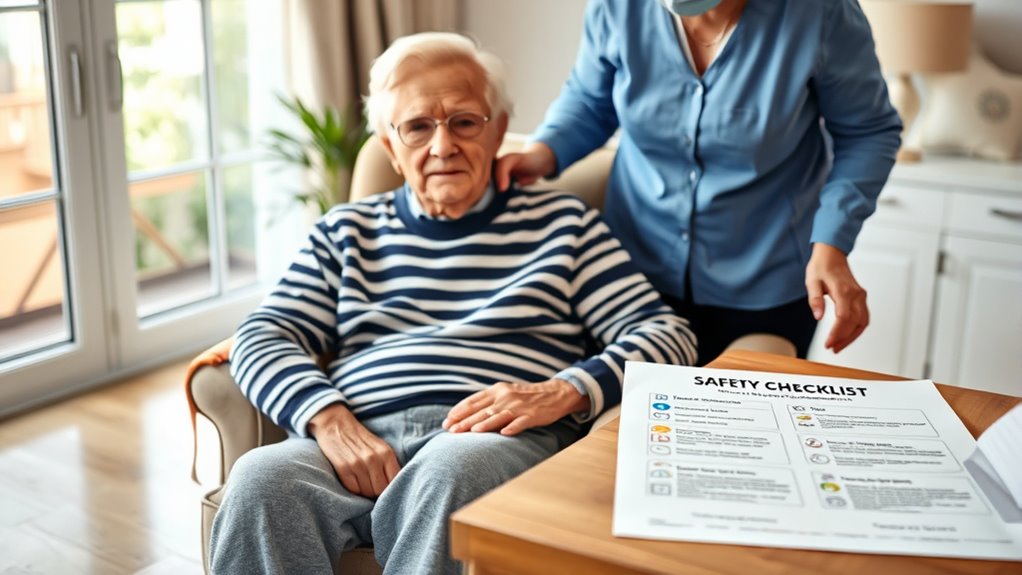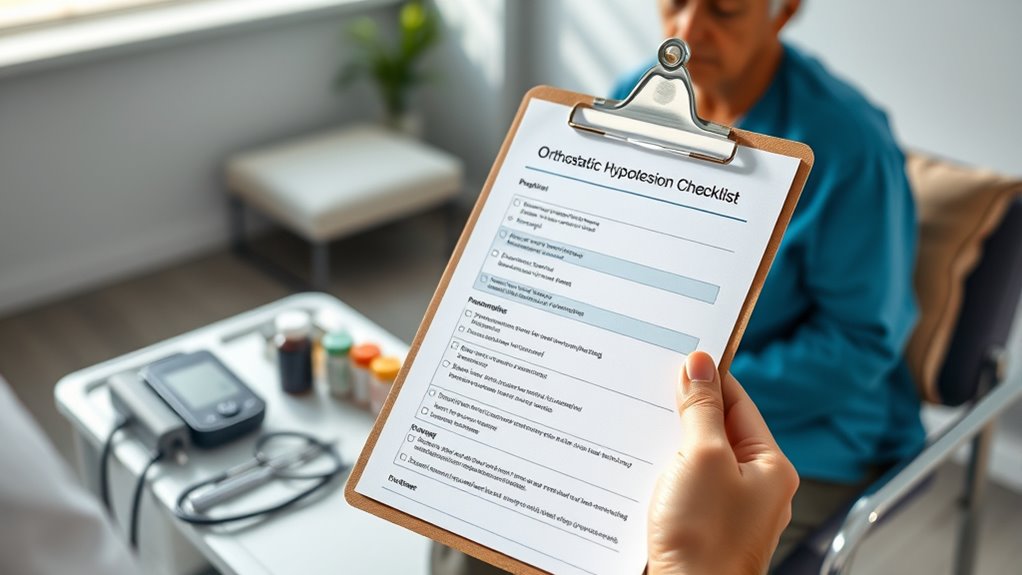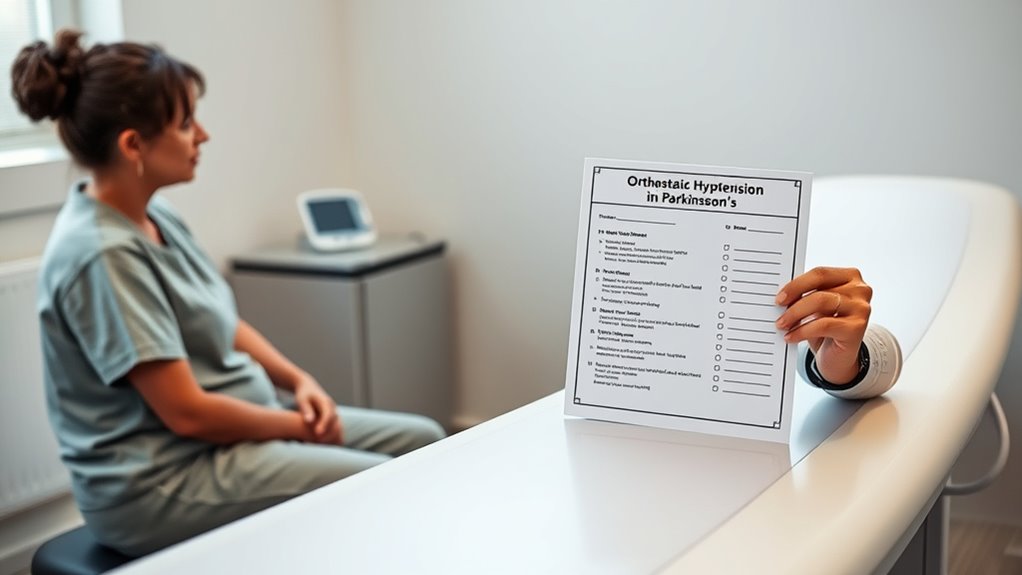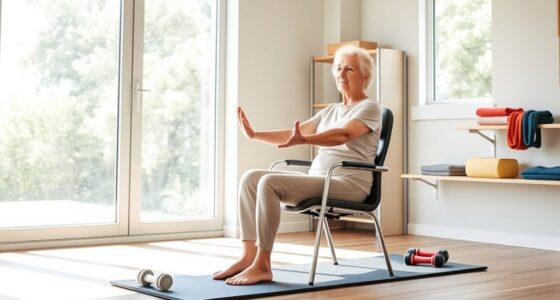To stay safe with orthostatic hypotension in Parkinson’s, recognize early symptoms like dizziness, blurred vision, and balance issues. When symptoms appear, sit or lie down immediately, and move slowly when changing positions. Keep your environment clutter-free, use grab bars, and wear support stockings. Stay well-hydrated and coordinate with your healthcare provider on medication timing. Following these safety steps can prevent falls and injuries—learn more tips to protect your independence and manage symptoms effectively.
Key Takeaways
- Regularly monitor blood pressure, especially during position changes, to detect early signs of orthostatic hypotension.
- Implement safety measures like using grab bars, non-slip rugs, and clutter-free walkways at home.
- Rise slowly from sitting or lying positions and sit down immediately if dizziness occurs.
- Use supportive devices such as compression stockings and stay well-hydrated to prevent blood pressure drops.
- Educate patients and caregivers on recognizing symptoms and emergency procedures to prevent falls and injuries.
Understanding Orthostatic Hypotension in Parkinson’s

Orthostatic hypotension is a common and often overlooked condition in people with Parkinson’s disease. It happens when your blood pressure drops suddenly when you stand up, leading to dizziness or lightheadedness. This occurs because your body’s mechanisms that regulate blood pressure don’t work as effectively, especially when Parkinson’s affects your autonomic nervous system. As a result, blood may not reach your brain quickly enough, causing faintness or even falls. Understanding this condition is vital because it can happen unexpectedly, especially during shifts from sitting or lying down to standing. Being aware of how and why it occurs helps you recognize potential risks and take proactive steps to manage or prevent symptoms. This knowledge empowers you to stay safer and more aware of your body’s responses. Additionally, color accuracy in your environment can influence your perception and help you identify early symptoms, enabling timely intervention.
Recognizing Symptoms and Early Signs

You might notice dizziness or lightheadedness when you stand up quickly, which can be an early sign of orthostatic hypotension. Sudden drops in blood pressure may cause you to feel faint or unsteady, especially during activity or after changing positions. You could also experience visual changes or balance problems that signal your body isn’t adjusting properly. Monitoring blood pressure changes regularly can help detect symptoms early and prevent falls. Using monitoring techniques that track blood pressure fluctuations in real-time can enhance early detection and intervention. Understanding how automation in healthcare can assist in tracking these vital signs might improve management strategies. Proper beneficiary designation in retirement accounts can also reduce the risk of unexpected complications related to health changes. Incorporating vital sign monitoring devices into daily routines can further support early detection efforts.
Dizziness and Lightheadedness
Dizziness and lightheadedness are common early signs of orthostatic hypotension in people with Parkinson’s. You might notice these feelings when you stand up quickly or change positions. They can feel like a sensation of spinning, unsteadiness, or a fainting urge. Sometimes, the dizziness may come on suddenly and last for a few moments, especially after sitting or lying down for a while. Recognizing these signs early is essential to prevent falls or injuries. If you experience dizziness, sit or lie down immediately and avoid standing up too quickly. Keeping track of when these symptoms occur helps you and your healthcare team identify patterns and adjust your management plan to improve safety.
Dizziness and lightheadedness are common early signs of orthostatic hypotension in people with Parkinson’s. You might notice these feelings when you stand up quickly or change positions. They can feel like a spinning sensation, unsteadiness, or a fainting urge. Sometimes, the dizziness comes suddenly and lasts only a few moments, especially after sitting or lying down for a while. Recognizing these signs early is crucial to avoid falls or injuries. If you experience dizziness, sit or lie down right away and avoid moving quickly. Tracking when these symptoms happen helps you and your healthcare team make necessary adjustments to keep you safe.
Sudden Blood Pressure Drops
Sudden drops in blood pressure can occur rapidly when you stand up or change positions, causing momentary but significant symptoms. You might feel a quick wave of weakness, dizziness, or even a brief feeling of faintness. These drops happen when blood vessels don’t respond quickly enough to maintain steady pressure, especially in Parkinson’s. You may notice a sudden sense of lightheadedness or feel like you’re about to pass out. Sometimes, your vision might blur or darken temporarily. These signs are warning you that your blood pressure has dropped suddenly. Recognizing these early symptoms helps you take quick action, like sitting or lying down, to prevent falls or injury. Staying alert to these signs is vital for managing orthostatic hypotension safely.
Visual and Balance Changes
Changes in vision and balance often serve as early warning signs of orthostatic hypotension in Parkinson’s. You might notice blurred or dimming vision when you stand up quickly, making it harder to see clearly or focus. You could also feel unsteady or wobbly, especially when shifting from sitting to standing. These symptoms occur because blood pressure drops suddenly, reducing blood flow to your brain and eyes. Recognizing these signs early helps you take precautions, like sitting down immediately or using support. Pay attention to any dizziness, lightheadedness, or feeling faint alongside visual or balance changes. Addressing these symptoms promptly can reduce fall risk and improve your safety. Always report these early signs to your healthcare provider for proper management.
Medications and Treatment Strategies

You need to carefully choose medications and decide when to take them to minimize orthostatic hypotension. Adjusting treatment plans as symptoms change can help manage blood pressure drops effectively. By staying vigilant, you can optimize your therapy and reduce the risk of falls or dizziness. Incorporating best medication practices can further enhance safety and treatment outcomes. Understanding the principles of ethical hacking can help healthcare providers identify vulnerabilities in medical devices and protect patient data. Additionally, supporting patients emotionally through treatment adjustments can improve adherence and overall well-being.
Medication Selection and Timing
Choosing the right medications and timing is essential for managing orthostatic hypotension in Parkinson’s patients. You should select medications that effectively raise blood pressure without worsening Parkinson’s symptoms or causing side effects. Often, clinicians recommend short-acting agents like fludrocortisone or midodrine, taken when blood pressure dips most. Timing is critical: taking medications early in the day can prevent symptoms during activities, while avoiding doses late in the afternoon minimizes supine hypertension at night. You should also coordinate medication schedules with meals and other treatments to optimize effectiveness. Regularly monitor your blood pressure to understand how your medications impact your symptoms. Adjusting timing based on your daily routine helps maintain stability and reduces the risk of falls or dizziness.
Adjusting Treatment Plans
Adjusting treatment plans for orthostatic hypotension in Parkinson’s involves regularly evaluating how medications and strategies work together to maintain blood pressure stability. You should monitor symptoms closely and be ready to modify dosages or switch medications if blood pressure remains too low or fluctuations worsen. Combining non-pharmacologic methods, like increasing fluid intake or wearing compression stockings, with medications can improve outcomes. It’s essential to communicate with your healthcare provider about any side effects or new symptoms. Sometimes, adjusting the timing of medications or introducing new drugs may be necessary to reduce orthostatic drops. Flexibility in your treatment approach helps you avoid falls and improve your quality of life while managing Parkinson’s symptoms effectively.
Daily Routine Modifications for Safety

To reduce the risk of falls and dizziness caused by orthostatic hypotension, implementing daily routine modifications is essential. Start your day slowly by rising gradually from bed, sitting on the edge for a moment before standing. When you need to move, take small, deliberate steps instead of rushing. Stay well-hydrated throughout the day to maintain blood volume, and avoid large meals that can cause blood pressure drops. Incorporate short, gentle exercises into your routine to improve circulation, but do so under medical guidance. If you feel dizzy, sit or lie down immediately and avoid sudden movements. Regularly check how you feel before standing, and give yourself extra time to *shift* from sitting or lying positions. Being aware of necessary cookies can help you manage your browsing experience and access helpful resources. Practicing proper postural adjustments can further help prevent episodes of dizziness and promote stability during daily activities. Understanding how blood pressure regulation works can empower you to make safer choices during your daily routines. Additionally, staying informed about security measures can help you feel more confident and secure in your environment, reducing stress-related dizziness. Recognizing the importance of ice cream consumption in health management can also motivate you to adopt better dietary habits. These small changes can *considerably* enhance your safety and reduce dizziness episodes.
Home Environment Adjustments

Creating a safe home environment is key to preventing falls and managing orthostatic hypotension. You should minimize hazards and ensure easy access to essentials. Use rugs with non-slip pads and keep walkways clear of clutter. Install grab bars in the bathroom, especially near the toilet and shower, and ensure good lighting everywhere. Place frequently used items at waist level to avoid unnecessary bending or reaching. To help you stay steady, consider using a sturdy chair or bench for resting during the day. Here’s a quick guide:
| Area | Adjustment | Purpose |
|---|---|---|
| Bathroom | Grab bars, non-slip mats | Prevent falls |
| Hallways | Clear pathways, good lighting | Reduce tripping hazards |
| Living Room | Stable furniture, unobstructed space | Enhance stability |
| Kitchen | Easy-to-reach shelves, clutter-free | Minimize bending/reaching |
| Bedroom | Bed at proper height, clear space | Safe transfers |
Additionally, maintaining good postural stability can help reduce dizziness and improve overall safety at home. Ensuring proper body positioning when moving or standing can further decrease the risk of orthostatic symptoms. Incorporating adaptive home modifications such as lever-style door handles and threshold ramps can also make daily activities safer and easier. Regularly checking and maintaining home safety features can further reduce fall risks.
Emergency Response Procedures

In an emergency situation related to orthostatic hypotension, quick and calm action can prevent serious injury. First, if you feel dizzy or faint, sit or lie down immediately to reduce the risk of falling. Keep your head lower than your heart to improve blood flow. If possible, loosen tight clothing and ensure you’re in a safe, stable position. Stay calm and breathe deeply to help restore your circulation. If symptoms persist or worsen, call for help or emergency services. Once stabilized, sit for a few minutes before standing again slowly. After the incident, assess what caused the episode and notify your healthcare provider. Acting swiftly and calmly can minimize injury and help you regain control safely.
Importance of Hydration and Nutrition

Staying well-hydrated and maintaining proper nutrition are crucial for managing orthostatic hypotension in Parkinson’s patients. When your body stays hydrated, your blood volume stays adequate, helping to prevent sudden drops in blood pressure when you stand up. Drink water consistently throughout the day, and consider adding electrolyte-rich beverages if recommended by your healthcare provider. Proper nutrition also plays a essential role; eating small, frequent meals prevents blood pressure from dropping after large, heavy meals. Include foods rich in vitamins and minerals to support overall health and blood vessel function. Avoid alcohol and caffeine in excess, as they can dehydrate you or cause blood pressure fluctuations. Prioritize hydration and balanced nutrition to help stabilize your blood pressure and reduce dizziness. Additionally, incorporating regular physical activity can improve cardiovascular health and help regulate blood pressure levels.
Collaborating With Healthcare Providers

Working closely with your healthcare providers is key to effectively managing orthostatic hypotension in Parkinson’s. Regular communication helps them understand your symptoms and any changes you experience. Make sure to keep a detailed symptom journal, noting when drops in blood pressure occur and any triggers. Your providers can adjust medications or recommend specific treatments to reduce risks. Follow their advice on blood pressure monitoring and medication schedules strictly. Don’t hesitate to ask questions about your condition or about new symptoms. Collaborating with your healthcare team also involves discussing lifestyle modifications and safety measures. By staying proactive and engaged, you can better control symptoms and prevent complications, ensuring a safer, more comfortable daily life.
Supporting Independence While Ensuring Safety

Balancing independence with safety is essential for managing orthostatic hypotension in Parkinson’s. You want to stay active and autonomous, but safety precautions are vital. Use assistive devices like grab bars or walking aids to support your mobility without feeling limited. Plan your activities to include rests and avoid rushing. Always test your blood pressure before standing, especially if you feel dizzy. Consider the following safety checklist:
| Safety Step | Supporting Independence |
|---|---|
| Use handrails and grab bars | Maintain confidence during transfers |
| Sit or lie down if dizzy | Prevent falls while staying active |
| Keep essentials within reach | Reduce unnecessary movement |
| Monitor your symptoms and stay aware of blood pressure changes | Empower yourself to recognize early warning signs |
Implementing these strategies helps you stay independent safely. Additionally, staying informed about health management techniques can empower you to better handle symptoms and prevent falls, ultimately maintaining your quality of life. Regular monitoring of blood pressure is also crucial to detect and manage orthostatic hypotension effectively. Being aware of self-care strategies can further enhance your safety and independence.
Frequently Asked Questions
How Can Caregivers Monitor Blood Pressure Effectively at Home?
You can monitor blood pressure effectively at home by using a digital blood pressure monitor regularly. Before measuring, sit quietly for five minutes, then take your reading while seated with feet flat on the floor and arm supported at heart level. Record your results daily at the same time. Keep the cuff snug but comfortable, and avoid caffeine or exercise 30 minutes before measuring to guarantee accurate readings.
Are There Specific Exercises to Prevent Orthostatic Drops?
You can do specific exercises to help prevent orthostatic drops. Focus on leg strengthening activities like calf raises and ankle pumps to improve blood flow. Incorporate seated leg lifts and gentle stretching to enhance circulation. Always move slowly from sitting to standing, and avoid sudden changes in position. Consistent practice of these exercises, combined with staying hydrated, can help reduce the risk of blood pressure drops when you change positions.
What Are the Long-Term Risks of Untreated Orthostatic Hypotension?
Oh, the thrilling world of untreated orthostatic hypotension—what could possibly go wrong? If you ignore it, you risk fainting, falls, and serious injuries that could turn your daily routine into a dangerous game of chance. Over time, it might damage your brain and heart, making life less lively and more hazardous. So, better to manage it early than to become a cautionary tale in the making.
How Does Posture Influence Symptom Severity During Daily Activities?
Your posture markedly impacts how severe symptoms feel during daily activities. When you stand or sit upright, blood may pool in your legs, causing dizziness or lightheadedness. Slouching or leaning forward can reduce these effects, but poor posture might worsen symptoms over time. To minimize discomfort, try to maintain a steady, upright position, shift your weight regularly, and avoid sudden movements. Proper posture keeps blood flowing smoothly, helping you feel steadier throughout the day.
Can Dietary Supplements Improve Blood Pressure Stability in Parkinson’S?
Sure, because a handful of magic supplements will suddenly turn your blood pressure into a perfectly steady tide, right? While some dietary supplements like salt, caffeine, and certain herbs might help, they’re not foolproof. You should talk to your doctor before adding anything new. Proper hydration, medication management, and lifestyle adjustments remain your best allies in stabilizing blood pressure and avoiding those dizzy, unplanned dance moves.
Conclusion
So, while managing Parkinson’s and orthostatic hypotension might feel like walking a tightrope, remember, your safety checklist is your safety net. Who knew that staying upright and hydrated could be such a balancing act? Irony aside, by following these tips, you’re actually taking control—proving that even when life throws a curveball, you can stay steady and safe. After all, sometimes the simplest steps make the biggest difference.









